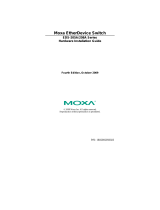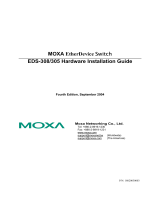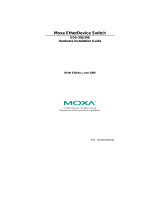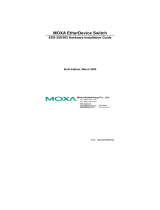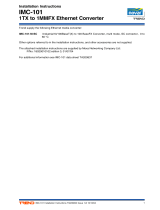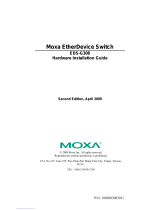Page is loading ...

2014 Moxa Inc. All rights reserved.
P/N: 1802002050025
EDS-205A/208A Series
Hardware Installation Guide
Moxa EtherDevice Switch
Sixth Edition, April 2014

- 2 -
Overview
The EDS-205A/208A series of industrial Ethernet switches are entry-level
industrial 5 and 8-port Ethernet switches that support IEEE 802.3, IEEE
802.3u, and IEEE 802.3x with 10/100M, full/half-duplex, and MDI/MDIX
auto-sensing.
The EDS-205A/208A series provides 12/24/48 VDC (9.6 to 60 VDC)/18 to
30 VAC redundant power inputs that can be connected simultaneously to
a live AC/DC power source. The switches are available with a standard
operating temperature range from -10 to 60°C, or with a wide operating
temperature range from -40 to 75°C, and IP30 metal housing makes
them rugged enough for any harsh industrial environment.
To provide greater versatility for use with applications from different
industries, the EDS-205A/208A also allow users to enable or disable
broadcast storm protection with DIP switches on the outer panel.
The EDS-205A/208A switches can be easily installed with DIN-Rail
mounting as well as distribution boxes. The DIN-rail mounting capability
and IP30 metal housing with LED indicators make the plug-and-play
EDS-205A/208A switches reliable and easy to use.
NOTE
Throughout this Hardware Installation Guide, we use EDS as an
abbreviation f
or Moxa EtherDevice Switch:
EDS = Moxa EtherDevice Switch
ATTENTION
This device complies with part 15 of FCC Rules. Operation is
subject to the following two conditions: (1) This device may not
cause harmful interference,
and (2) this device must accept any
interference received, including interference that may cause
undesired operation.
Package Checklist
Your EDS is shipped with the following items. If any of these items is
missing or damaged, please contact your customer service
representative for assistance.
• Moxa EtherDevice™ Switch
• Hardware Installation Guide
• Moxa Product Warranty booklet

- 3 -
Panel Layout of EDS-205A/208A (Standard)
1. Grounding screw
2. Terminal block for
power input P1/P2
3. Heat dissipation orifices
4. DIP Switches
5. Power input P1 LED
6. Power input P2 LED
7. 10/100BaseT(X) Port
8. TP port’s 10/100 Mbps
LED
9. Model Name
10.
Screw hole for wall
mounting kit
11.
DIN-Rail Kit

- 4 -
Panel Layout of EDS-205A-M-SC/ST
NOTE:
The appearance of
EDS
-205A-S-SC is identical
to EDS
-205A-M-SC.
1. Grounding screw
2. Terminal block for
power input P1/P2
3.
Heat dissipation orifices
4. DIP Switches
5. Power input P1 LED
6. Power input P2 LED
7. 10/100BaseT(X) Port
8. TP port’s 10/100 Mbps
LED
9. Model Name
10.
100BaseFX Port
11.
FX port’
s 100 Mbps LED
12.
Screw hole for wall
mounting kit
13.
DIN-Rail Kit

- 5 -
Panel Layout of EDS-208A-M-SC/ST
NOTE:
The appearance of
EDS
-208A-S-SC is identical
to EDS
-208A-M-SC.
1. Grounding screw
2. Terminal block for
power input P1/P2
3. Heat dissipation orifices
4. DIP Switches
5. Power input P1 LED
6. Power input P2 LED
7. 10/100BaseT(X) Port
8. TP port’s 10/100 Mbps
LED
9. Model Name
10.
100BaseFX Port
11.
FX port’
s 100 Mbps LED
12.
Screw hole for wall
mounting kit
13.
DIN-Rail Kit

- 6 -
Panel Layout of EDS-208A-MM-SC/ST
NOTE:
The appearance of
EDS
-208A-SS-SC
is identical
to EDS
-208A-MM-SC.
1. Grounding screw
2. Terminal block for
power input P1/P2
3. Heat dissipation orifices
4. DIP Switches
5. Power input P1 LED
6. Power input P2 LED
7. 10/100BaseT(X) Port
8. TP port’s 10/100 Mbps
LED
9. Model Name
10.
100BaseFX Port
11.
FX port’
s 100 Mbps LED
12.
Screw hole for wall
mounting kit
13.
DIN-Rail Kit

- 7 -
Mounting Dimensions
EDS-205A
EDS-208A
Unit = mm (inch)

- 8 -
DIN-Rail Mounting
The aluminum DIN-rail attachment plate should already be fixed to the
back panel of the EDS when you take it out of the box. If you need to
reattach the DIN-rail attachment plate, make sure the stiff metal spring is
situated towards the top, as shown in the figures below.
STEP 1:
Insert the top of the DIN
-Rail into
the slot
just below the stiff metal
spring.
STEP 2:
The DIN
-Rail attachment unit will
snap into
place as shown below.
To remove the EDS from the DIN-Rail, simply reverse Steps 1 and 2
above.
Wall Mounting (optional)
For some applications, you will find it convenient to mount the
EDS-205A/208A on the wall, as shown in the following figures.
STEP 1:
Remove the aluminum
DIN
-Rail attachment plate
from
the EDS-205A/208A’s
rear panel, and then attach
the wall mount plates as
shown
in the diagram at the
right.
STEP 2: Mounting the EDS-205A/208A on the wall
requires 4 screws. Use the
switch, with wall mount
plates attached, as a guide to mark the correct
locations of the 4 screws. The heads of the screws
should be less than 6.0 mm in diameter, and the shafts
should be less than 3.5
mm in diameter, as shown in
the figure at the right.
NOTE
Before tightening the screws into the wall, make sure the screw
head and shank size are suitable by inserting the screw into one
of the keyhole-shaped apertures of the wall mounting plates.
Do not screw the screws in completely—leave about 2 mm to allow room
for sliding the wall mount panel between the wall and the screws.

- 9 -
STEP 3:
Once the screws are fixed on the
wall, insert the four screw heads
through the large parts of the
keyhole
-
shaped apertures, and then
slide
the EDS-205A/208A
downwards
, as indicated. Tighten
the four screws for
added stability.
ATEX Information
1. Certificate number DEMKO 10 ATEX 0909900X
2. Ambient range (-40°C ≤ Tamb ≤ 75°C)
3. Certification string (Ex nA nC IIC T4 Gc)
4. Standards covered (EN 60079-0:2012, EN 60079-15:2010)
5. The conditions of safe usage:
• Subject devices are for use in ambient temperature -40°C
≤Tamb ≤ +75°C.
• Subject devices are to be installed in an IP54 enclosure.
•
Subject devices are for use in an area of not more than pollution
degree 2 in accordance with IEC 60664-1.
• Subject devices are to use Conductors suitable for use in an
ambient temperature of 100°C must be used for the Power
Supply Terminal.
Wiring Requirements
WARNING
Safety First!
Turn the power off before
disconnecting modules or wires. The
correct power supply voltage is listed on the product label. Check
the voltage of your power source to make sure that you are using
the correct voltage. Do
NOT use a voltage greater than what is
specified on the product
label.
These devices must be supplied by a SELV source as defined in
the Low Voltage Directive 2006/95/EC and 2004/108/EC.
WARNING
Safety First!
Calculate the maximum possible current in each power wire and
common wire.
Observe all electrical codes dictating the
maximum current allowable for each wire size.
If the current goes above the maximum ratings, the wiring could
overheat, causing serious damage to your equipment.

- 10 -
You should also pay attention to the following points:
• Use separate paths to route wiring for power and devices. If power
wiring and device wiring paths must cross, make sure the wires are
perpendicular at the intersection point.
NOTE: Do not run signal or communications wiring and power wiring
in the same wire conduit. To avoid interference, wires with different
signal characteristics should be routed separately.
• You can use the type of signal transmitted through a wire to
determine which wires should be kept separate. The rule of thumb is
that wiring that shares similar electrical characteristics can be
bundled together.
• Keep input wiring and output wiring separated.
• It is strongly advised that you label wiring to all devices in the system
when necessary.
Grounding the EtherDevice Switch
Grounding and wire routing help limit the effects of noise due to
electromagnetic interference (EMI). Run the ground connection from the
ground screw to the grounding surface prior to connecting devices.
ATTENTION
This product is
intended to be mounted to a well-grounded
mounting surface such as a metal panel.
Wiring the Redundant Power Inputs
The top two contacts and the bottom two contacts of the 4-contact
terminal block connector on the EDS’s top panel are used for the EDS’s
two AC/DC inputs. Top and front views of one of the terminal block
connectors are shown here.
STEP 1:
Insert the negative/positive AC
/DC wires into the
V
-/V+ terminals.
STEP 2:
To keep the AC
/DC wires from pulling loose, use a
small flat
-blade screwdriver to tighten the wire-
clamp
screws on the front of the terminal block connector.
STEP 3:
Insert the plastic terminal block connector prongs into
the terminal block receptor, which is located on EDS’s
top panel.
ATTENTION
Before connecting the EtherDevice Switch to the
AC/DC power
inputs, make sure the AC/DC power source voltage is stable.

- 11 -
Communication Connections
The EDS-205A models have 4 or 5 10/100BaseT(X) Ethernet ports, and 1
or 0 (zero) 100 BaseFX multi/single-mode (SC/ST-type connector) fiber
ports. The EDS-208A models have 6, 7 or 8 10/100BaseT(X) Ethernet
ports, and 2, 1 or 0 (zero) 100 BaseFX multi/single-mode (SC/ST-type
connector) fiber ports.
10/100BaseT(X) Ethernet Port Connection
The 10/100BaseT(X) ports located on the EDS’s front panel are used to
connect to Ethernet-enabled devices. Below we show pinouts for both
MDI (NIC-type) ports and MDI-X (HUB/Switch-type) ports, and also show
cable wiring diagrams for straight-through and cross-over Ethernet
cables.
10/100Base T(x) RJ45 Pinouts
MDI Port Pinouts
MDI-X Port Pinouts
8-pin RJ45
Pin
Signal
1
Tx+
2
Tx-
3
Rx+
6
Rx-
Pin
Signal
1
Rx+
2
Rx-
3
Tx+
6
Tx-
RJ45 (8-pin) to RJ45 (8-pin) Straight-Through Cable Wiring
RJ45 (8-pin) to RJ45 (8-pin) Cross-Over Cable Wiring

- 12 -
100BaseFX Ethernet Port Connection
The concept behind the SC/ST port and cable is quite straightforward.
Suppose you are connecting devices I and II; contrary to electrical signals,
optical signals do not require a circuit in order to transmit data.
Consequently, one of the optical lines is used to transmit data from device
I to device II, and the other optical line is used transmit data from device
II to device I, for full-duplex transmission.
Remember to connect the Tx (transmit) port of device I to the Rx (receive)
port of device II, and the Rx (receive) port of device I to the Tx (transmit)
port of device II. If you make your own cable, we suggest labeling the two
sides of the same line with the same letter (A-to-A and B-to-B, as shown
below, or A1-to-A2 and B1-to-B2).
SC-Port Pinouts
SC-Port to SC-Port Cable Wiring
ST-Port Pinouts
ST-Port to ST-Port Cable Wiring
ATTENTION
This is a Class 1 Laser/LED product. To avoid causing serious
damage to your eyes, do not stare directly into the Laser Beam.
Redundant Power Inputs
Both power inputs can be connected simultaneously to live AC/DC power
sources. If one power source fails, the other live source acts as a backup,
and automatically supplies all of the EDS’s power needs.

- 13 -
DIP Switch Settings
EDS-205A/208A DIP Switches
The default setting for each DIP Switch is O
FF
.
The
following table explains the effect of
setting the DIP Switches to the O
N positions.
DIP Switch
Setting
Description
----
Serves no function (reserved for future use).
BSP
ON
Enables broadcast storm protection
OFF
Disables broadcast storm protection
ATTENTION
To actively updated DIP switch settings, power off and then
power on the EDS.
LED Indicators
The front panel of the Moxa EtherDevice Switch contains several LED
indicators. The function of each LED is described in the table below.
LED
Color
State
Description
P1 AMBER
On
Power is being supplied to power input P1.
Off
Power is not being supplied to power input P1.
P2 AMBER
On
Power is being supplied to power input P2.
Off
Power is not being supplied to power input P2.
10M Yellow
On
TP port’s 10 Mbps link is active.
Blinking
Data is being transmitted at 10 Mbps.
Off
TP Port’s 10 Mbps link is inactive
100M GREEN
On
TP port’s 100 Mbps link is active.
Blinking
Data is being transmitted at 100 Mbps.
Off
100Base TP Port’s link is inactive.
Auto MDI/MDI-X Connection
The Auto MDI/MDI-X function allows users to connect the EDS’s
10/100BaseTX ports to any kind of Ethernet device, without needing to
pay attention to the type of Ethernet cable being used for the connection.
This means that you can use either a straight-through cable or cross-over
cable to connect the EDS to Ethernet devices.
Dual Speed Functionality and Switching
The Moxa EtherDevice Switch’s 10/100 Mbps switched RJ45 port auto
negotiates with the connected device for the fastest data transmission
rate supported by both devices. All models of Moxa EtherDevice Switch
are plug-and-play devices, so that software configuration is not required
at installation, or during maintenance. The half/full duplex mode for the
switched RJ45 ports is user dependent and changes (by auto-negotiation)
to full or half duplex, depending on which transmission speed is supported
by the attached device.

- 14 -
Switching, Filtering, and Forwarding
Each time a packet arrives at one of the switched ports, a decision is
made to either filter or forward the packet. Packets with source and
destination addresses belonging to the same port segment will be filtered,
constraining those packets to one port, and relieving the rest of the
network from the need to process them. A packet with destination
address on another port segment will be forwarded to the appropriate
port, and will not be sent to ports where it is not needed. Packets that are
used in maintaining the operation of the network (such as the occasional
multi-cast packet) are forwarded to all ports. The EDS operates in the
store-and-forward switching mode, which eliminates bad packets and
enables peak performance to be achieved when there is heavy traffic on
the network.
Switching and Address Learning
The EDS has an address table that can hold up to 1024 addresses, which
makes it suitable for use with large networks. The address tables are
self-learning, so that as nodes are added or removed, or moved from one
segment to another, the EDS automatically keeps up with new node
locations. An address-aging algorithm causes the least-used addresses to
be deleted in favor of newer, more frequently used addresses. To reset
the address buffer, power down the unit and then power it back up.
Auto-Negotiation and Speed Sensing
All of the EDS’s RJ45 Ethernet ports independently support
auto-negotiation for speeds in the 10BaseT and 100BaseTX modes, with
operation according to the IEEE 802.3u standard. This means that some
nodes could be operating at 10 Mbps, while at the same time, other nodes
are operating at 100 Mbps. Auto-negotiation takes place when an RJ45
cable connection is made, and then each time a LINK is enabled. The EDS
advertises its capability for using either 10 Mbps or 100 Mbps
transmission speeds, with the device at the other end of the cable
expected to advertise in a similar manner. Depending on what type of
device is connected, this will result in agreement to operate at a speed of
either 10 Mbps or 100 Mbps. If an EDS RJ45 Ethernet port is connected to
a non-negotiating device, it will default to 10 Mbps speed and half-duplex
mode, as required by the IEEE 802.3u standard.
Specifications
Technology
Standards
IEEE 802.3 for 10BaseT,
IEEE 802.3u for 100BaseT(X) and 100BaseFX,
IEEE 802.3x for Flow Control
Processing Type
Store and Forward
Flow Control
IEEE 802.3x flow control, back pressure flow
control
Interface
RJ45 Ports 10/100BaseT(X) auto negotiation speed, F/H
duplex mode, and auto MDI/MDI-X
connection
Fiber Ports
100BaseFX ports (SC/ST connector,
multi/single-mode)

- 15 -
LED Indicators
P1, P2 (Power), 10/100M (TP port), and 100M
(Fiber port)
DIP Switch
enable/disable broadcast storm protection
Optical Fiber
100BaseFX
Multi-mode
Single-mode
Wavelength
1300 nm
1310 nm
Max. TX
-10 dBm
0 dBm
Min. TX
-20 dBm
-5 dBm
RX Sensitivity
-32 dBm
-34 dBm
Link Budget
12 dB
29 dB
Typical Distance
5 km
a
40 km
c
4 km
b
Saturation
-6 dBm
-3 dBm
a. using [50/125μm, 800 MHz*km] cable
b. using [62.5/125μm, 500 MHz*km] cable
c. using [9/125 μm, 3.5 PS/(nm*km)] cable
Power
Input Voltage
12/24/48 VDC (9.6 to 60 VDC),
18 to 30VAC (47 to 63 Hz)
Input Current @ 24VDC
0.1 A (EDS-205A)
0.11 A (EDS-205A-M/S)
0.13 A (EDS-208A)
0.17 A (EDS-208A-M/S)
0.22 A (EDS-208A-MM/SS)
Connection
Removable 4-contact terminal block
Overload Current
Protection
1.1 A
Reverse Polarity
Protection
Present
Physical Characteristics
Housing
IP30 protection, metal case
Dimensions
EDS-208A Series: 50 x 115 x 70 mm
EDS-205A: 30 x 115 x 70 mm
Weight
EDS-208A Series: 275 g
EDS-205A: 175 g
Installation DIN-Rail Mounting, Wall Mounting
(with optional kit)
Environmental Limits
Operating Temperature
-10 to 60°C (14 to 140°F)
-40 to 75°C (-40 to 167°F) for -T models
Storage Temperature
-40 to 85°C (-40 to 185°F)
Ambient Relative Humidity
5 to 95% (non-condensing)
Regulatory Approvals
Safety
UL508
Hazardous Location UL/cUL Class I, Division 2, Groups A, B, C, and
D; ATEX Zone 2, Ex nA nC IIC T4 Gc
Maritime
DNV, GL, ABS, LR, NK
Rail Traffic
EN 50121-4
EMI
FCC Part 15, CISPR (EN 55022) class A
EMS
EN 61000-4-2 (ESD), Level 3
EN 61000-4-3 (RS), Level 3

- 16 -
EN 61000-4-4 (EFT), Level 3
EN 61000-4-5 (Surge), Level 3
EN 61000-4-6 (CS), Level 3
EN 61000-4-8
EN 61000-4-11
Shock
IEC 60068-2-27
Freefall
IEC 60068-2-32
Vibration
IEC 60068-2-6
WARRANTY
5 years
Technical Support Contact Information
www.moxa.com/support
Moxa Americas:
Toll
-free: 1-888-669-2872
Tel:
1-714-528-6777
Fax:
1-714-528-6778
Moxa China (Shanghai office):
Toll
-free: 800-820-5036
Tel:
+86-21-5258-9955
Fax:
+86-21-5258-5505
Moxa Europe
:
Tel:
+49-89-3 70 03 99-0
Fax:
+49-89-3 70 03 99-99
Moxa Asia
-Pacific:
Tel:
+886-2-8919-1230
Fax:
+886-2-8919-1231
/
